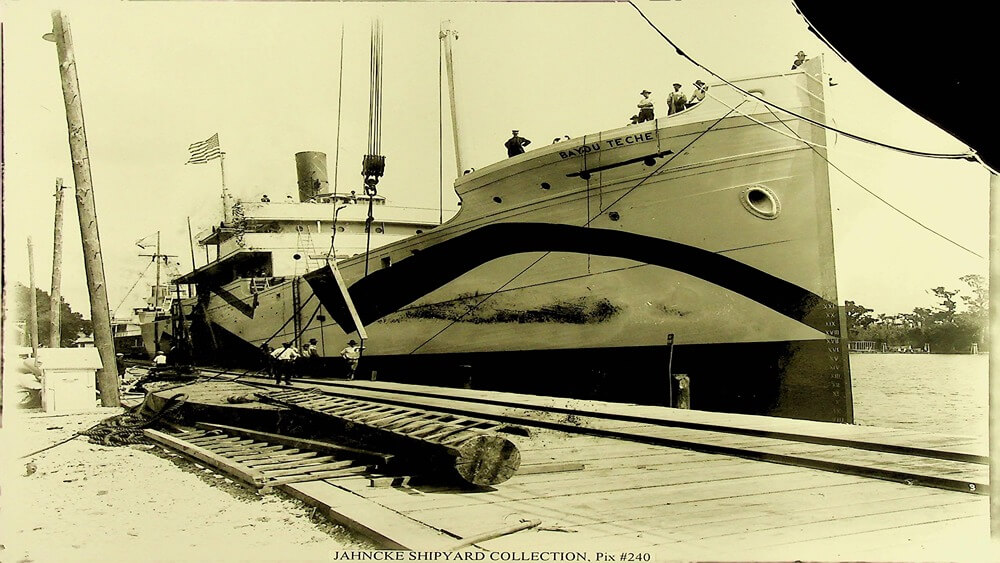The Shipwrecks of Mallows Bay-Potomac River National Marine Sanctuary

The sanctuary boasts a diverse collection of historic shipwrecks dating back to the Revolutionary War, but is most renowned for the remains of over 100 wooden steamships known as the Ghost Fleet. The ships were built for the U.S. Emergency Fleet between 1917-1919 as part of America's engagement in World War I. Their construction at more than 40 shipyards in 17 states reflected a massive wartime effort that drove the expansion and economic development of communities and related maritime services. Although nearly 300 ships were built, the war ended before the fleet was complete. Some of them carried cargo to Hawai‘i and elsewhere, but none made it to the theater of war.
Historical Background
Ship building during World War I brought about the formalization of merchant mariners. Although merchant mariners already existed in the United States, the building, operation, and maintenance of hundreds of new vessels meant that significantly more skilled mariners were needed.
Although 100 wooden warships were built, the war ended before the ships could be used. Many of them were scuttled to the Potomac River for the purpose of salvaging scrap metal, such as engines, steam boilers, and propellers. They became known as the Ghost Fleet, which was partially dismantled through three separate shipbreaking and metal salvage periods from the 1920s through the 1940s.
Most of the ships were bought by Western Marine and Salvage Corporation and kept in the Potomac River near Mallows Bay. A few at a time were taken to Alexandria, Virginia, and broken down for scrap metal. Those remaining in the Potomac would occasionally catch fire, break loose, and become hazards to navigation, so the company was ordered to secure them. To do so, they burnt a large number of them to the waterline before floating them into Mallows Bay.
During the Depression era, Western Marine and Salvage Company went bankrupt, which opened the door for local communities on both sides of the river to salvage the ships’ remains and derive needed income. At the start of World War II, Baltimore's Bethlehem Steel initiated the third and final shipbreaking period, lasting only two years.


Ships as Valuable Habitats

Today, about 100 of the ships remain in the sanctuary and after more than a century, natural processes gradually transformed these ships into ecologically valuable habitats. The overgrown wrecks now form a series of distinctive islands, intertidal habitat, and underwater structure critical to fish, beavers, and birds, such as the osprey, blue heron, and bald eagle. Although the sanctuary does not manage or regulate these natural resources, the unique blending of history and ecology attracts and captivates visitors.
The Shipwrecks

Accomac
Starboard view of Accomac, with one osprey nest at the bow, and another at the stern. (Photo: Will Sassorossi/NOAA).

Afrania
Close up of Afrania with remains outlined in red. (Source: Duke University/NOAA).

Aowa
Remains of Aowa, stern in the foreground with the bow facing toward the Maryland shoreline. (Photo: Matt McIntosh/NOAA).

Bayou Teche
View of starboard side of Bayou Teche at Jahncke Shipyard, displaying dazzle painting, date unknown. (Source: Courtesy of Southeastern Louisiana University, Center for Southeast Louisiana Studies, Jahncke Shipyard Collection).

Benzonia
Close up of Benzonia, as part of a larger image mosaic that utilized drones. (Source: Duke University/NOAA).

Boone
The remains of Boone (centered of image), located within Mallows Bay-Potomac River National Marine Sanctuary. (Source: Duke University/NOAA).

Dertona
Moosabee and Dertona, two of the "Three Sisters" wrecks (lower left hand corner of the image), located in Mallows Bay-Potomac River National Marine Sanctuary. (Photo: Tyler Smith/NOAA).

Mono
"On The Job For Victory" poster showing a panoramic view of a busy shipyard, 1917, by United States Shipping Board Emergency Fleet Corporation. (Source: Library of Congress).

Moosabee
Aerial drone photographic mosaic of "Three Sisters" wrecks, located within Mallows Bay-Potomac River National Marine Sanctuary. (Source: Duke University/NOAA).

Namecki
Vessel Namecki displaying dazzle paint (camouflage), 1918. Dazzle paint was used in an effort to confuse the enemy by attempting to disguise the speed and heading (direction) of the vessel. (Source: Courtesy of the Fleet Library at Rhode Island School of Design, Special Collections).

Yawah
Launching of Contoocook (later named Yawah) at the Shattuck shipyard, Newington, NH, November 7, 1918. (Source: In memory of L. H. Shattuck and his daughter Althea, courtesy of the Portsmouth Athenaeum).

